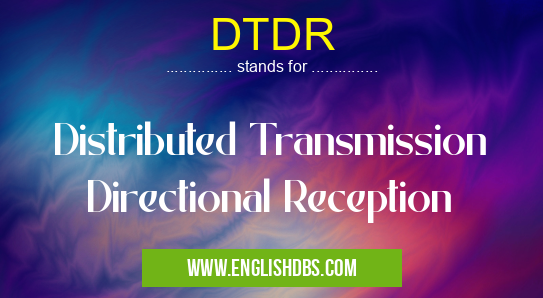What does DTDR mean in UNCLASSIFIED
DTDR is a wireless communication technology that combines distributed transmission and directional reception to improve communication range and reliability. It uses multiple transmitters and receivers spread across a wide area, with each transmitter sending a directional signal toward the receiver. This allows for more efficient use of the available spectrum and reduces interference from other signals.

DTDR meaning in Unclassified in Miscellaneous
DTDR mostly used in an acronym Unclassified in Category Miscellaneous that means Distributed Transmission Directional Reception
Shorthand: DTDR,
Full Form: Distributed Transmission Directional Reception
For more information of "Distributed Transmission Directional Reception", see the section below.
- DTDR (Distributed Transmission Directional Reception) is a wireless communication technique that employs multiple distributed transmit antennas and a single directional receive antenna.
- It is designed to improve the spatial diversity and signal quality in wireless networks.
Key Features of DTDR
- Distributed Transmit Antennas: Multiple antennas are distributed across a specific area, providing spatial diversity for transmission.
- Directional Receive Antenna: A single directional antenna is used at the receiver to enhance the signal reception.
- Beamforming: The transmit antennas cooperate to create a focused beam towards the receive antenna, improving signal strength and reducing interference.
Benefits of DTDR
- Improved Signal Quality: By focusing the transmission beam, DTDR enhances the signal strength and quality at the receiver.
- Reduced Interference: The directional nature of the receive antenna helps to mitigate interference from other nearby transmitters.
- Increased Capacity and Coverage: By employing multiple transmit antennas, DTDR can increase the channel capacity and extend the coverage area.
- Enhanced Reliability: The spatial diversity provided by the distributed transmit antennas improves the reliability of wireless communication links.
Applications of DTDR
- Wireless LANs (Wi-Fi)
- Cellular networks (4G/5G)
- Ad-hoc networks
- Wireless sensor networks
Essential Questions and Answers on Distributed Transmission Directional Reception in "MISCELLANEOUS»UNFILED"
What is Distributed Transmission Directional Reception (DTDR)?
How does DTDR improve communication range and reliability?
By using multiple transmitters and receivers, DTDR can distribute the transmission power and concentrate the signal in the direction of the intended receiver. This reduces the path loss experienced by the signal and improves the signal-to-noise ratio (SNR) at the receiver. As a result, the communication range can be extended, and the reliability of the connection can be improved.
What are the benefits of using DTDR compared to traditional wireless communication methods?
DTDR offers several benefits over traditional wireless communication methods, including:
- Extended communication range
- Improved reliability
- Reduced interference
- Increased spectral efficiency
- Enhanced security
What are some real-world applications of DTDR?
DTDR has a wide range of potential applications, including:
- Long-range wireless communication for remote areas
- Wireless sensor networks for industrial automation
- Underwater communication for marine exploration
- Vehicle-to-vehicle communication for autonomous driving
- Secure communication for military and government applications
Is DTDR a commercially available technology?
DTDR is still in the research and development phase, but there are efforts to commercialize the technology. Several companies and research institutions are working on developing DTDR products and solutions for various applications.
Final Words:
- DTDR is an innovative wireless communication technique that leverages distributed transmission and directional reception to improve signal quality, reduce interference, and enhance network performance.
- It is a promising solution for various wireless applications, particularly in environments with challenging signal conditions.
